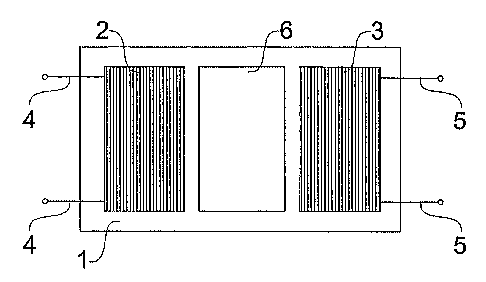Une partie des informations de ce site Web a été fournie par des sources externes. Le gouvernement du Canada n'assume aucune responsabilité concernant la précision, l'actualité ou la fiabilité des informations fournies par les sources externes. Les utilisateurs qui désirent employer cette information devraient consulter directement la source des informations. Le contenu fourni par les sources externes n'est pas assujetti aux exigences sur les langues officielles, la protection des renseignements personnels et l'accessibilité.
L'apparition de différences dans le texte et l'image des Revendications et de l'Abrégé dépend du moment auquel le document est publié. Les textes des Revendications et de l'Abrégé sont affichés :
| (12) Demande de brevet: | (11) CA 2581260 |
|---|---|
| (54) Titre français: | CAPTEUR DE GAZ A ONDE ACOUSTIQUE DE SURFACE COMPRENANT UNE COUCHE DE GETTER SENSIBLE ET PROCEDE PERMETTANT DE FABRIQUER CE CAPTEUR |
| (54) Titre anglais: | SURFACE ACOUSTIC WAVE GAS SENSOR WITH SENSITIVE GETTER LAYER AND PROCESS FOR ITS MANUFACTURE |
| Statut: | Réputée abandonnée et au-delà du délai pour le rétablissement - en attente de la réponse à l’avis de communication rejetée |
| (51) Classification internationale des brevets (CIB): |
|
|---|---|
| (72) Inventeurs : |
|
| (73) Titulaires : |
|
| (71) Demandeurs : |
|
| (74) Agent: | GOWLING WLG (CANADA) LLP |
| (74) Co-agent: | |
| (45) Délivré: | |
| (86) Date de dépôt PCT: | 2005-10-17 |
| (87) Mise à la disponibilité du public: | 2006-04-27 |
| Licence disponible: | S.O. |
| Cédé au domaine public: | S.O. |
| (25) Langue des documents déposés: | Anglais |
| Traité de coopération en matière de brevets (PCT): | Oui |
|---|---|
| (86) Numéro de la demande PCT: | PCT/IT2005/000605 |
| (87) Numéro de publication internationale PCT: | WO 2006043299 |
| (85) Entrée nationale: | 2007-03-21 |
| (30) Données de priorité de la demande: | ||||||
|---|---|---|---|---|---|---|
|
L'invention concerne un capteur de gaz à onde acoustique de surface, en particulier un capteur d'hydrogène ou un capteur de dépression, comprenant un substrat (1) piézoélectrique sur lequel est appliquée au moins une couche de matériau (6) sensible aux gaz intercalée entre deux transducteurs (2, 3) interdigités, et comprenant un getter, de telle manière que les molécules sorbées par le getter produisent une modification de la fréquence d'un signal transmis entre les deux transducteurs (2, 3). La présente invention se rapporte également à un procédé permettant de fabriquer ce capteur.
Surface acoustic wave gas sensor, in particular a vacuum or hydrogen sensor,
comprising a piezoelectric substrate (1) on which at least one layer of a gas-
sensitive material (6) is arranged between two inter-digital transducers (2,
3) and comprises a getter material, so that the molecules sorbed by this
getter material can vary the frequency of a signal transmitted between the two
transducers (2, 3). The present invention also relates to a process for
manufacturing this sensor.
Note : Les revendications sont présentées dans la langue officielle dans laquelle elles ont été soumises.
Note : Les descriptions sont présentées dans la langue officielle dans laquelle elles ont été soumises.

2024-08-01 : Dans le cadre de la transition vers les Brevets de nouvelle génération (BNG), la base de données sur les brevets canadiens (BDBC) contient désormais un Historique d'événement plus détaillé, qui reproduit le Journal des événements de notre nouvelle solution interne.
Veuillez noter que les événements débutant par « Inactive : » se réfèrent à des événements qui ne sont plus utilisés dans notre nouvelle solution interne.
Pour une meilleure compréhension de l'état de la demande ou brevet qui figure sur cette page, la rubrique Mise en garde , et les descriptions de Brevet , Historique d'événement , Taxes périodiques et Historique des paiements devraient être consultées.
| Description | Date |
|---|---|
| Le délai pour l'annulation est expiré | 2010-10-18 |
| Demande non rétablie avant l'échéance | 2010-10-18 |
| Réputée abandonnée - omission de répondre à un avis sur les taxes pour le maintien en état | 2009-10-19 |
| Inactive : Page couverture publiée | 2007-05-31 |
| Lettre envoyée | 2007-05-16 |
| Inactive : Notice - Entrée phase nat. - Pas de RE | 2007-05-16 |
| Demande reçue - PCT | 2007-04-13 |
| Exigences pour l'entrée dans la phase nationale - jugée conforme | 2007-03-21 |
| Demande publiée (accessible au public) | 2006-04-27 |
| Date d'abandonnement | Raison | Date de rétablissement |
|---|---|---|
| 2009-10-19 |
Le dernier paiement a été reçu le 2008-09-23
Avis : Si le paiement en totalité n'a pas été reçu au plus tard à la date indiquée, une taxe supplémentaire peut être imposée, soit une des taxes suivantes :
Veuillez vous référer à la page web des taxes sur les brevets de l'OPIC pour voir tous les montants actuels des taxes.
| Type de taxes | Anniversaire | Échéance | Date payée |
|---|---|---|---|
| Taxe nationale de base - générale | 2007-03-21 | ||
| Enregistrement d'un document | 2007-03-21 | ||
| TM (demande, 2e anniv.) - générale | 02 | 2007-10-17 | 2007-09-24 |
| TM (demande, 3e anniv.) - générale | 03 | 2008-10-17 | 2008-09-23 |
Les titulaires actuels et antérieures au dossier sont affichés en ordre alphabétique.
| Titulaires actuels au dossier |
|---|
| SAES GETTERS S.P.A. |
| Titulaires antérieures au dossier |
|---|
| MARCO AMIOTTI |